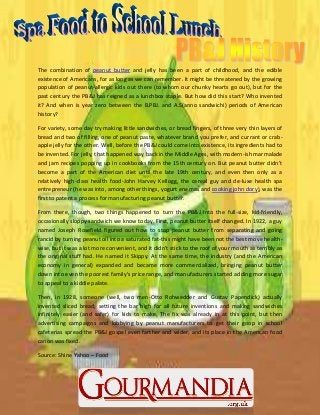
Spa Food to School Lunch
- 1. The combination of peanut butter and jelly has been a part of childhood, and the edible existence of Americans, for as long as we can remember. It might be threatened by the growing population of peanut-allergic kids out there (to whom our chunky hearts go out), but for the past century the PB&J has reigned as a lunchbox staple. But how did this start? Who invented it? And when is year zero between the B.PBJ. and A.S(anno sandwichi) periods of American history? For variety, some day try making little sandwiches, or bread fingers, of three very thin layers of bread and two of filling, one of peanut paste, whatever brand you prefer, and currant or crab- apple jelly for the other. Well, before the PB&J could come into existence, its ingredients had to be invented. For jelly, that happened way back in the Middle Ages, with modern-ish marmalade and jam recipes popping up in cookbooks from the 15th century on. But peanut butter didn't become a part of the American diet until the late 19th century, and even then only as a relatively high-class health food-John Harvey Kellogg, the cereal guy and de-luxe health spa entrepreneur (he was into, among other things, yogurt enemas and cooking john dory), was the first to patent a process for manufacturing peanut butter. From there, though, two things happened to turn the PB&J into the full-size, kid-friendly, occasionally sloppy sandwich we know today. First, peanut butter itself changed. In 1922, a guy named Joseph Rosefield figured out how to stop peanut butter from separating and going rancid by turning peanut oil into a saturated fat-this might have been not the best move health- wise, but it was a lot more convenient, and it didn't stick to the roof of your mouth as terribly as the original stuff had. He named it Skippy. At the same time, the industry (and the American economy in general) expanded and became more commercialized, bringing peanut butter down into even the poorest family's price range, and manufacturers started adding more sugar to appeal to a kiddie palate. Then, in 1928, someone (well, two men-Otto Rohwedder and Gustav Papendick) actually invented sliced bread, setting the bar high for all future inventions and making sandwiches infinitely easier (and safer) for kids to make. The fix was already in at this point, but then advertising campaigns and lobbying by peanut manufacturers to get their goop in school cafeterias spread the PB&J gospel even farther and wider, and its place in the American food canon was fixed. Source: Shine Yahoo – Food
